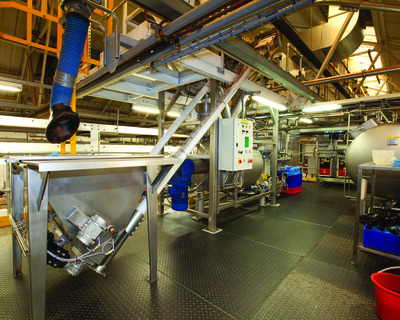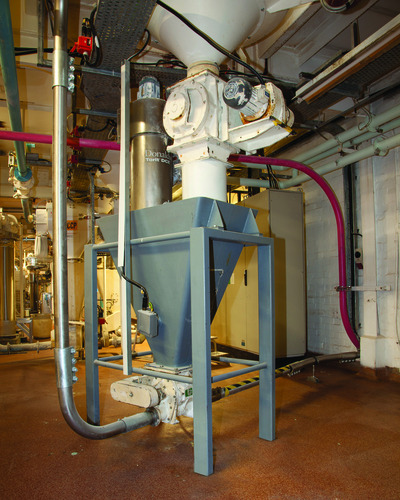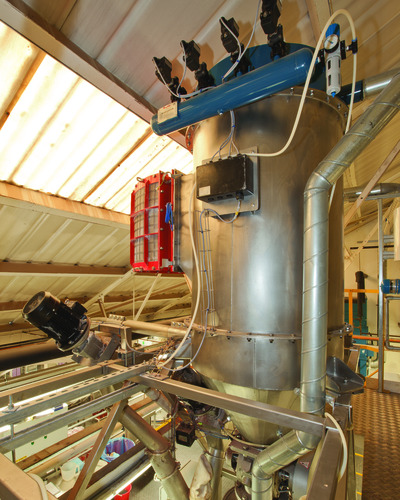Flexicon conveys Chocolate Dodger to success
Wednesday, 29 January, 2014
Following the success of its Jammie Dodger biscuit, Burton’s Biscuit Co decided to market a Chocolate Dodger version comprising chocolate cream sandwiched between two chocolate biscuits.
The biscuit producer engaged Flexicon to install a batching/blending system consisting of flexible screw conveyor that transports cocoa powder to a horizontal paddle mixer and a pneumatic conveying system that delivers finely milled sugar to the mixer. Flexicon designed both conveyors to overcome potential challenges associated with the materials.
Cocoa powder has a bulk density of around 560 kg/m2. The non-free-flowing powder has a tendency to pack and cake. Being hygroscopic, it also forms deposits on conveying equipment surfaces, particularly if exposed to moisture. It also fluidises readily and generates dust.
To handle the troublesome powder, Burton’s specified two Flexicon flexible screw conveyors with screw geometry suited to the application.
The chocolate cream recipe calls for 15 kg of one type of cocoa powder and 25 kg of another, both of which are manually dumped from 25 kg bags into a twin floor hopper that keeps them separate. The hopper consists of two narrow hoppers joined at a centre line, from which a hopper lid hinges to cover the opening of one hopper or the other.

A vacuum extraction system connected to both hoppers withdraws any fugitive dust generated from dumping activities. The hoppers are also equipped with an electromagnetic vibration system that promotes flow of material into the inlets of flexible screw conveyors that transport cocoa to the mixture.
Each conveyor consists of a stainless steel flexible screw, housed in a 3 m long, 90 mm OD plastic tube that is inclined at 70°. From the discharge spouts of both conveyors, material flows to a common wye fitting and then through a single downspout that discharges into the mixer.
The screw is driven by a 2.2 kW motor located above the discharge point of the tube, thereby preventing powder from contacting drive seals.
The screw is engineered with special geometry to minimise radial forces and maximise longitudinal flow of the material to prevent packing of the compressible material. As the flexible screw rotates, it self-centres within the tube providing clearance between the screw and the tube wall to minimise grinding or heating/melting of the powder.
The conveyors are started and stopped by the PLC to move 15 kg of one cocoa powder, and then 25 kg of the other, to the mixer. Each conveyor moves material at the full feed rate of 1.85 m3/h, and then steps down to trickle feed rate before stopping once the accurate target weight is gained by the mixer.
Unlike cocoa powder, the sugar powder needed for the process is free-flowing (when dry) and is sourced from a distant plant location, leading Burton’s to specify a Pneumati-Con pneumatic conveying system, also from Flexicon Europe.

The plant receives sugar in granulated form, which is milled to a fine powder, and then fed from a hopper through a rotary valve into a 200 m long, 75 mm diameter stainless steel pneumatic line.
Powered by a blower located upstream from the sugar intake point, the pneumatic conveyor has a capacity of 2110 kg/h. Since the fine powder will readily agglomerate and block the line in the presence of moisture, a key requirement is to keep the sugar warm and dry - achieved by means of a dehumidification system. Dean Miles, Burton’s engineering projects manager, points out that this is especially critical because the pneumatic line contains four 90° elbows and four 30° elbows where plugging would otherwise occur.
A 915 mm diameter filter receiver separates the sugar from the airstream, before it enters a 500 kg capacity receiving hopper, located above the mixer. Four air-jet fluidisers in the bottom of the hopper promote the flow of material as it is fed into the mixer by a rotary valve under PLC control, according to weight gain input provided by the mixer’s load cells.

Just before entering the mixer, the sugar passes through a 915 mm diameter vibratory screen with 1.0 mm openings, which retains oversize material. Once palm oil and liquid chocolate are added to the batch, the PLC cycles the mixer, opens a discharge valve, and pumps the chocolate cream blend to the sandwich production line.
Initially, Burton’s ordered the pneumatic system, which was the more critical of the installations because of the distance the sugar had to be conveyed. “Flexicon started the installation two months after we ordered it,” said Miles.
“At that point we had confidence in the company, so we ordered the flexible screw conveyor system and started producing the chocolate cream and Chocolate Dodger sandwiches two months later. Flexicon met the lead times we were dealing with and their price was competitive.”

The equipment is inspected only once a month and requires minimal attention, Miles says. “We run residual material out at the end of every production run and wipe down the hoppers and connecting pieces for the delivery pipework and screw feeder. If we need to clean a flexible tube we can take it off and clean it in 10 minutes,” Miles said.
“It’s the right kind of system for us and it works well. We can load it up and leave it to look after itself.”
Four trends shaping warehouse automation and intralogistics in 2025
Four key trends expected to shape the warehouse automation and intralogistics industry in...
Unlocking AI: strategic moves to revolutionise the food sector
As the AI transformation gathers pace, we can expect AI tools to become established in the food...
The development of food GMPs
Good manufacturing practices (GMPs) in the food industry are in place to ensure that the products...













